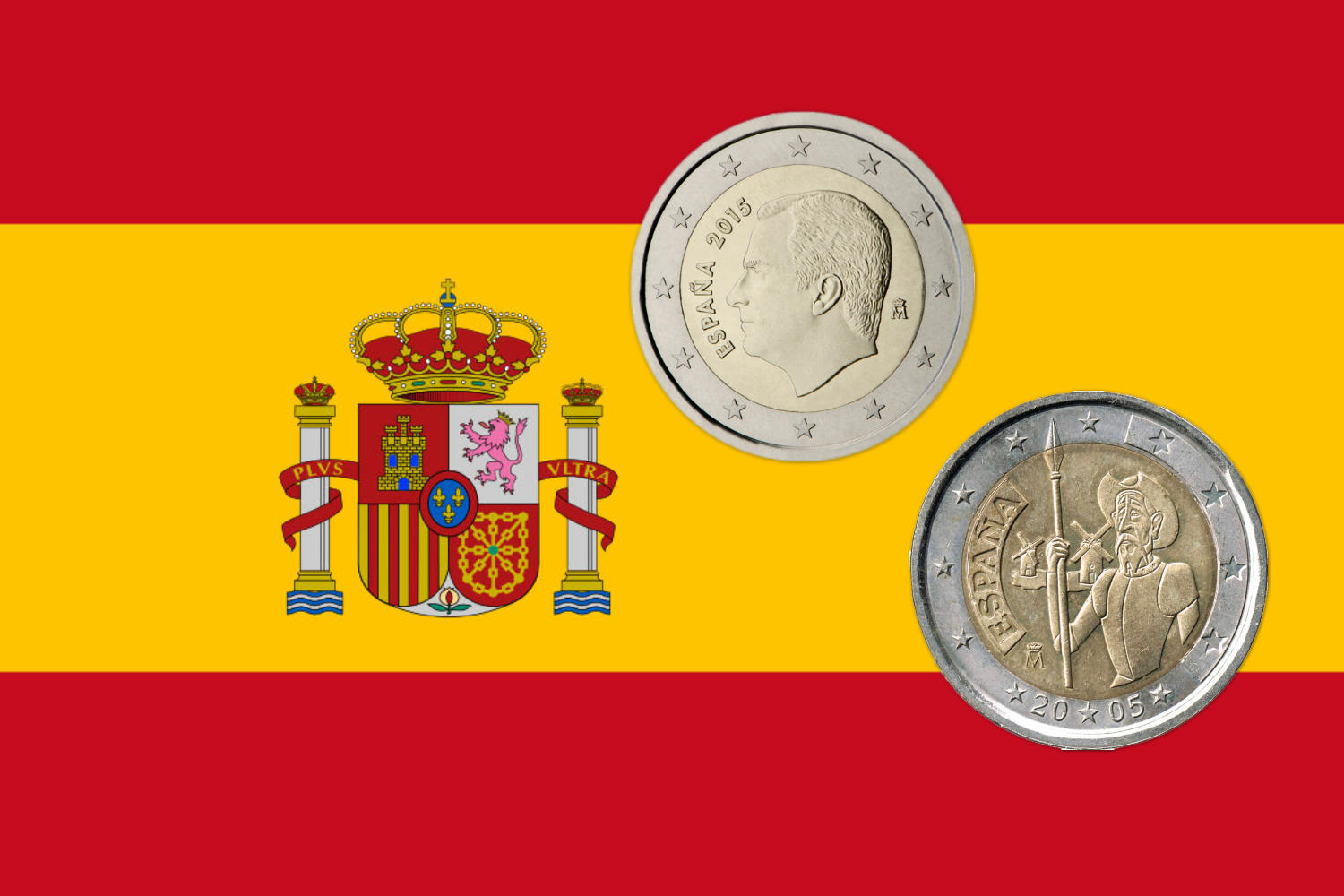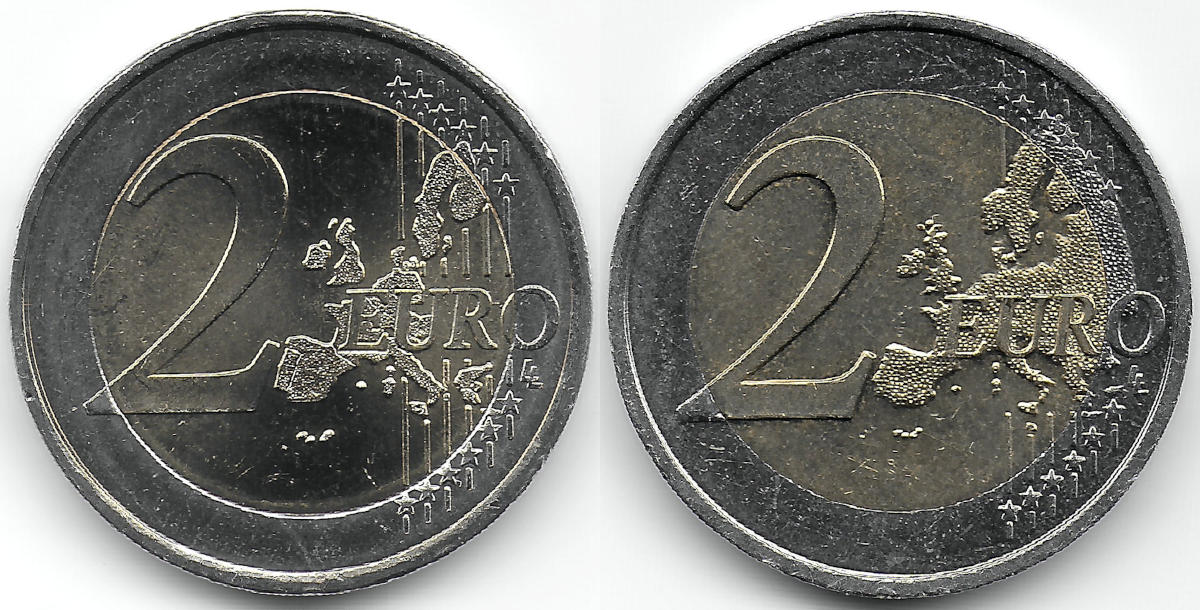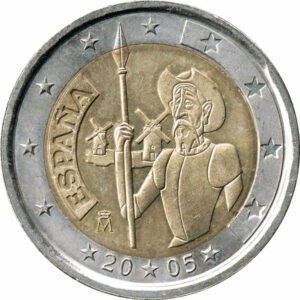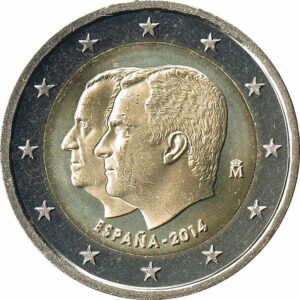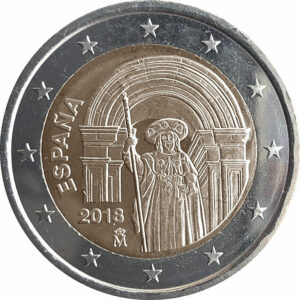Collectible Treasures: 2-Euro Commemorative Coins from Spain
All Spanish euro coins including 2-euro pieces are produced by the Fábrica Nacional de Moneda y Timbre (FNMT) in Madrid. Since Spain is a popular vacation destination, the coins often turn up in Central European wallets. However, the coveted 2-euro commemorative coins are hardly ever found. Collectors have to make do with the secondary market – at least most pieces are offered in mint state quality there. Of course, there are also error coins among Spanish pieces. However, collectors had better ignore coins offered at astronomical prices. You should rather stick to the classics such as off-centred coins, die cracks or punching errors. Only buy pieces which you can identify as “genuine” error coins. By now, there is a wide range of online sellers offering error coins. Unfortunately, most of them are minting coincidences or even manipulations. These coins are by no means worth your money. So be cautious! Today, I would like to draw your attention to some interesting 2-euro commemorative coins from Spain – pieces with potential.
2-Euro Circulation Coins
The Kingdom of Spain is one of the countries that introduced the euro as their sole currency in 2002. Over the past twenty years, some very interesting 2-euro commemorative coins were issued. In addition, there was a change of sovereign, which can be experienced on circulation coins issued after 2015. The reverse design (RV) meets the requirements set for all euro countries. The year on the pieces corresponds to the year of minting, which is why coins of 1999, 2000 or 2001 are not rare. The obverse (OBV) featured King Juan Carlos I from 1999–2014. Minor changes to the design of the OBV were made in 2010. Since 2015, 2-euro circulation coins have depicted King Felipe VI. All coins are produced by the Spanish mint in Madrid.
Just like 2-euro commemorative coins, all 2-euro circulation coins consist of a ring made of cupronickel. The core is made of nickel brass with a nickel core (CuNi / Ni, CuNiZn plated). All pieces can slightly be attracted by a magnet at the centre.
Technical Specifications
- Weight: 8.50g
- Diameter: 25.75mm
- Reeded edge
- In addition to the reeded edge, all Spanish coins feature the inscription “2” (six times) followed by two alternately inverted stars on the edge.
Particularities
Coloured or even gilded pieces aren’t official issues. They have been doctored and lost their former value as currency. Some coins show a larger gap between ring and centre, this is no minting error but a mere coincidence. Starting in 2010, changes were made regarding the OBV. The year of minting is no longer placed on the ring at the bottom but in the centre on the left. The mint mark is no longer on the left of the King’s portrait but on the right. The circular elements on the left and the right completely disappeared from the OBV.
Mint Error Coins
We know of coins with minor punching errors on both sides. There are a few off-centre strikes whose edge is not reeded in some places. Such features show you that the specimen is an actual mint error coin. In addition, weak strikes that make the design look slightly faded (for example the stars) are quite common. The euro stars also come in different sizes. However, these features do not identify an error coin! Nevertheless, look for minor punching errors, die cracks and rotated die error coins as they occur rather frequently.
Appraisal
2-euro circulation coins from Spain can often be found in circulation. However, coins with the portrait of King Felipe VI (minted in or after 2015) are quite rare. Mint state specimens can be purchased on the secondary market for prices between 6 and 10 euros. Prices for coins with punching errors on both sides start at 20 euros. However, you should never spend more on such a coin! Off-centred issues are more expensive, prices start at 70 euros. Weak strikes are worth between 10 and 20 euros, depending on the extent. Don’t be impressed by the astronomical prices some sellers ask for online. Although many online dealers offer so-called error coins, they have no idea what actual error coins are and they are usually unable to tell you more about it. They just want to make money. Don’t fall for such offers!
Joint Issues of the Eurozone
The Kingdom of Spain participated in all four joint issues of the eurozone of 2007, 2009, 2012 and 2015. So far, no “actual” error coins were found. There are specimens of the 2009 issue with small or large euro stars on the OBV. Pieces with large stars are already worth up to 30 euros on the secondary market. Prices are likely to increase even further. Prices for pieces with small stars start at 10 euros. These coins are very rarely or not at all found in circulation. On the secondary market, prices for mint state specimens start at 10 euros. I recommend collectors to get one specimen of all four joint issues as quickly as possible. With the release of the fifth joint issue, prices of the coins that were issued before might increase rather quickly.
Technical Specifications
The technical specifications correspond to those of a 2-euro circulation coin.
400 Years Don Quixote 2005
Spain’s first 2-euro commemorative coin is dedicated to the popular fictional character Don Quixote (Don Quijote). It depicts the “knight of the sorrowful countenance” with lance. In the background are two windmills of the kind Don Quixote bravely fights in the novel. The mark of the Madrid mint is on the bottom left, the year of minting on the bottom on the ring.
Technical Specifications
The technical specifications correspond to those of a 2-euro circulation coin.
Particularities
Coloured or gilded pieces are not official issues. They have been doctored and lost their former value as currency.
This is the only Spanish 2-euro commemorative coin whose design still includes the two circular elements on the OBV. Later issues were minted without them.
Mint Error Coins
So far, no mint error coins have been found. Nevertheless, look for minor punching errors, die cracks and rotated die error coins.
Appraisal
These coins can hardly be found in circulation. On the secondary market, prices for mint state specimens start at 6 euros.
King Felipe VI – Accession to the Spanish Throne, 2014
Since 19 June 2014, Felipe VI has been King of Spain and thus the head of state. The former King Juan Carlos I (1975–2014) had abdicated before. The OBV shows the portraits of both monarchs. In the foreground, the portrait of King Felipe VI. On the right, the mark of the Madrid mint. Below the country’s name and the year of minting.
Technical Specifications
The technical specifications correspond to those of a 2-euro circulation coin.
Particularities
Coloured or gilded pieces are not official issues. They have been doctored and lost their former value as currency.
Mint Error Coins
So far, no mint error coins have been found. Nevertheless, keep looking for minor punching errors, die cracks and rotated die error coins.
Appraisal
These coins can hardly be found in circulation. On the secondary market, prices for mint state specimens are still quite low and start at 5 euros. However, prices might increase quickly.
UNESCO World Heritage Sites in Spain, Cathedral of Santiago de Compostela, 2018
The 9th issue of the UNESCO World Heritage Sites in Spain series is dedicated to the famous Cathedral of Santiago de Compostela. This cathedral is the destination of every pilgrim on the Way of St. James. The OBV depicts a statue of St. James the Apostle right in front of the Holy Door of the Cathedral. On the right is the name of the country, below the year of minting and the mark of the Spanish mint in Madrid.
Technical Specifications
The technical specifications correspond to those of a 2-euro circulation coin.
Particularities
Coloured or gilded pieces are not official issues. They have been doctored and lost their former value as currency. The piece seems to be quite popular because it is rather expensive compared to other 2-euro commemorative coins. Interested collectors should therefore quickly purchase a specimen. Due to a mintage figure of 300,000 pieces, the coin has long been one of Spain’s rarities.
Mint Error Coins
So far, no mint error coins have been found. Nevertheless, keep looking for minor punching errors, die cracks and rotated die error coins.
Appraisal
These coins can hardly be found in circulation. On the secondary market, mint state specimens are expensive and prices usually start at 20 euros. In this case, too, the price is expected to rise.
In the online database Cosmos of Collectibles you can find all 2-euro coins of Spain.
Don’t miss out on new coin issues! Subscribe to the Cosmos of Collectibles newsletter for free.
The author numiscontrol already dealt with the rarities among 2-euro commemorative coins of other countries, too. Here you can read his articles on coins from
And here you can find his series on rare 2 euro pieces from Germany and on the joint EU issues (in German).
Find out more about our author numiscontrol, alias Reiner Graff, in our Who’s Who.
The collecting expert made it his mission to introduce beginners to the world of coin collecting – here you can read his series “Coin Care in Simple Terms”.







